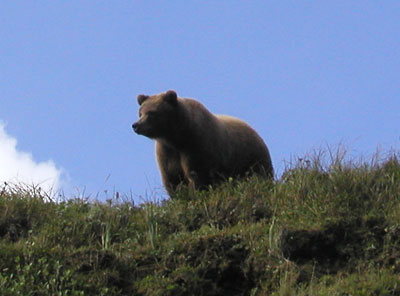
Top carnivore, Alaska Peninsula—How would the presence or absence of the brown bear affect CZ (Critical Zone) processes?
Credit: Tim White, 2003.
Ecology, the study of the interactions between organisms and the environment, can be arranged into categories mostly based on increasingly generalized interactions between multiple organisms and their habitat. For example:
- Organismal ecology studies a specific organism's structure, physiology, and behavior
- Population ecology studies a group of a single organism
- Community ecology studies interactions between different organisms
- Ecosystem ecology emphasizes energy flow and biogeochemical cycles
- Landscape ecologists study mosaics of connected ecosystems
- Global ecology recognizes that the biosphere is truly a global system—the sum of Earth's ecosystems and landscapes
Activity
For this activity, I want you to continue working on the 3–4-page paper that you began on page 3 of this lesson.
Directions
NOTE:
For this assignment, you will need to record your work on a word processing document. Your work must be submitted in Word (.doc) or PDF (.pdf) format so I can open it. In addition, documents must be double-spaced and typed in 12 point Times Roman font.
- To learn more about the interactions between organisms I want you to read the following book chapter, located in Library Reserves: Chapter 52 from Biology by Campbell & Reece (8th edition), "An Introduction to Ecology and the Biosphere."
- While reading this chapter, pay particular attention to the descriptions of biotic and abiotic factors that control organismal interactions. Consider dispersal by natural range expansion and species transplantation, as well as behavioral and habitat selection.
- The section on climate should be review—feel free to skip it or use it as a review.
- Read the section on aquatic biomes, noting that lakes, wetlands, streams, and rivers are all part of the Critical Zone. While coastal zones are included in the Critical Zone, most of the section on oceanic biomes is irrelevant to this course and you can skip it.
- The "Terrestrial Biomes" section is important—read it carefully, paying attention to the section "Exploring Terrestrial Biomes" and keeping in mind that we will return to this subject in more detail in Lesson 11.
- Study the climograph comparing major biome types in North America. As you do so, record your answers to the following questions on the paper you began on page 3 of this lesson:
- How does your study site fit into the climograph?
- Does the generalized biome indicated on the climograph match your site biome?
- Summarize the biotic and abiotic characteristics of your site that most influence on-site ecology and interactions in the Critical Zone.
- Do you expect global warming will alter the ecology of your site? Be specific: use estimates of changes in temperature and precipitation gleaned from Lesson 5 when you read about regional climate change in North America with some case studies.
- Next, read the following book chapter, located in Library Reserves: Chapter 29 from Biology of Plants by Raven et al (5th edition), "The Dynamics of Communities and Ecosystems."
- Though this chapter focuses on plants, many of the concepts apply to all life and the reading is clear and succinct.
- Leave this chapter with a good understanding of terms like population, community, ecosystem, and biome.
- Also be clear on the interactions between organisms, particularly the concepts of mutualism and competition.
- Nutrient cycles, trophic levels, and community and ecosystem development are also well described and should be understood by the completion of this reading.
- Finally, read the following book chapter, located in Library Reserves: Chapter 55 from Biology by Campbell & Reece (8th edition), "Ecosystems."
- You will read and learn in more detail about energy flow and efficiency, biogeochemical cycling, and primary production.
- Focus your attention on the section on terrestrial ecosystems and closely study the figure comparing evapotranspiration (ET) to net primary productivity (NPP).
- Continue your writing assignment for this lesson by responding to the following questions as you work through the Campbell reading.
- Does the ET v. NPP figure provide any insight into ecological processes at your study site? If so, what?
- What processes of decomposition and nutrient cycling are most evident at your site? Use the mean annual temperature (MAT) v. % litter mass lost figure in considering this final question.
- Note that we will return to the final section on "Dominance of Human Activities" in Lesson 12.
- Re-save your document and continue with this lesson.